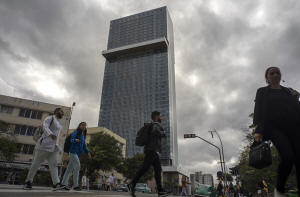A new luxury hotel towers over Havana as Cuba's economic troubles mount
and tourism plummets
 Send a link to a friend
Send a link to a friend
 [January 25, 2025] By
ANDREA RODRÍGUEZ [January 25, 2025] By
ANDREA RODRÍGUEZ
HAVANA (AP) — It’s impossible to miss. The huge rectangular mass of
concrete and glass — the tallest building in Havana — dominates the city
skyline, towering 150 meters (490 feet) above colonial homes with its
542 luxury rooms and majestic views of the city and the sea.
The Selection La Habana hotel, managed by Spanish chain Iberostar, has
yet to be inaugurated but it is already the target of criticism — and
not only for its unusual shape. Cubans are questioning the government’s
allocation of millions of dollars towards luxury tourism while the
island grapples with a severe economic crisis and tourism numbers
plummet to historic lows.
“All that money could have been spent to build hospitals and schools,”
lamented Susel Borges, a 26-year-old artisan, as she looked up to the
towering edifice, known to locals as the “K and 23 building” because of
its location.
Located near the legendary Habana Libre hotel and the iconic Coppelia
ice cream parlor, the new hotel is part of a government plan to build a
dozen luxury establishments — mainly in Havana — that did not stop even
during the COVID-19 pandemic and while existing luxury hotels remained
largely unoccupied.
For decades, tourism drove the Cuban economy, generating annual revenues
of up to $3 billion. But in December, Cuban authorities said only 2.2
million tourists visited the island in 2024, a decrease of roughly
200,000 from 2023 and significantly lower than the 4.2 million tourists
who visited in 2019.
The government attributes the decline in tourism to a “perfect storm” of
factors including supply shortages, a severe energy crisis causing
massive blackouts and a lack of personnel, due to emigration and low
wages. Furthermore, the island is grappling with a surge in U.S.
sanctions, including restrictions on travel by U.S. citizens, a ban on
cruise ships and other measures specifically designed to stifle the
growth of Cuba’s tourism industry.

[to top of second column] |

People walk past the Selection La Habana new hotel, managed by
Spanish chain Iberostar, in Havana, Cuba, Friday, Jan. 24, 2025. (AP
Photo/Ramon Espinosa)
 “Tourism is gone,” said Julio García
Campos, driver of a shiny red 1951 Pontiac with an original engine.
“Tourists used to line up to get on one of these!” he said,
recalling a bygone era when the island was bustling with American
and European travelers following a removal of sanctions by
then-President Barack Obama.
The new Selection La Habana, like all other hotels in Cuba, is
state-owned and operates under GAESA, a conglomerate belonging to
the Ministry of the Revolutionary Armed Forces that has often been
criticized because of the opacity of its businesses. As a
military-run operation, it is exempt from audits by the Comptroller
General’s Office and has not disclosed the amount it invested in the
40-story hotel.
Cuban economist Pedro Monreal notes the “incongruity” of investing
capital in the tourism sector when very little is being allocated to
strategic areas such as agriculture.
"With food insecurity a concern, it’s troubling that agricultural
investment lags significantly behind tourism investment, remaining
11 times lower,” Monreal noted last year on social media.
Architects also expressed little enthusiasm for the new hotel,
pointing at its disruptive appearance within the environment, its
excessive height violating urban regulations and tall glass windows
that are ill-suited for a tropical climate.
“This building serves as a perfect example in our classes of what
should not be done in terms of bioclimatic design,” said Abel
Tablada, an architect and university professor, adding it's
"unforgivable" that the little money available to the Cuban state
has been allocated to a building that does not add value to the
city.
All contents © copyright 2025 Associated Press. All rights reserved |